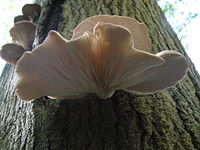
Photo from wikipedia
The red yeast (Rhodotorula mucilaginosa: Rho) has abundant extracellular polymeric substances (EPS) and intracellular vesicles (Ves). This study explored the mechanisms of Rho to resist Cu toxicity from extracellular to… Click to show full abstract
The red yeast (Rhodotorula mucilaginosa: Rho) has abundant extracellular polymeric substances (EPS) and intracellular vesicles (Ves). This study explored the mechanisms of Rho to resist Cu toxicity from extracellular to intracellular, i.e., EPS, membrane, and Ves. The Cu2+ concentrations were set from 0 to 200 mg/L. In contrast to other heavy metals (e.g., Pb2+), low Cu2+ stress has no evident stimulation to EPS production. In particular, GSH content in EPS did not show significant changes. The Cu removal was decreased from ~ 35 to ~ 0% as Cu stress raised from 0 to 200 mg/L, which confirmed the low binding of Cu cations to EPS. Moreover, redox peaks at - 0.35 V (reduction) and - 0.02 V (oxidation) in EPS were observed based on electrochemical analysis. Subsequently, the potential Haber-Weiss reaction in EPS lowered fungal ability to shield against the Cu toxicity. Then, the contrast of Cu concentration between the extracellular and intracellular regions was enlarged. Moreover, the thickness of cell membrane decreased from 450 to 116 nm during the elevation of Cu stress. These accelerated the transport of Cu cations into intracellular, but the redox reaction in both cell membrane and intracellular region was limited. Under transmission electron microscopy, the intracellular Ves showed evident sorption of Cu cations (100 mg/L). However, the Ves started to deform and gradually lost their activity at 200 mg/L. Therefore, this study successfully elucidated the correlated extracellular and intracellular mechanisms of metal detoxification by yeast. KEY POINTS: •This study provides a comprehensive explanation for the invasion of Cu2+ into fungal (Rhodotorula mucilaginosa) cells based on microbial physiological and biochemical analysis, electrochemical analysis, and transmitted electron microscopy. •Cu nanoparticles are involved in redox reactions in the EPS, thus greatly reducing the prophase protection for fungal cells by EPS. •At 200 mg/L Cu2+ stress, deformation of cell membrane intensifies the contrast of Cu concentrations between extra- and intracellular regions. This further suppresses the transportation of Cu2+ by intracellular vesicles. Graphical abstract.
Journal Title: Applied microbiology and biotechnology
Year Published: 2020
Link to full text (if available)
Share on Social Media: Sign Up to like & get
recommendations!